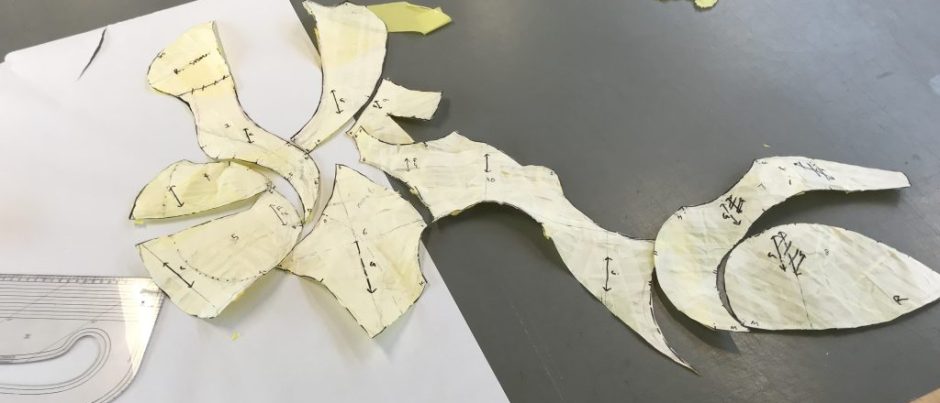Taking the analysis of the data from the focus group forwards, I planned two workshops. One clothes swap on…, and one a mending workshop on…, as proposed to students within the focus group.
I advertised these through Moodle, through posters on the wall, and word of mouth in the costume studio, rather than the targeted, individual selection of the first action research cycle. This was to deliberately open up the research to target those who do not frequent costume so much, to speak to those issue which my literature review and focus group raised around a lack of confidence in skills and abilities (barriers to accessing technical support, and therefore sustainable practices support). The concept was that students would be motivated to come to the second workshop, having gained something form the first workshop that maybe needs a small alteration.


The cumulative aim of these two workshops was to gain data on how successfully students with little or no existing costuming skills could be drawn into the space, to become familiar with it, and initiate some “eco-somatic thinking” (Pantouvaki, 2021), and hopefully visit again soon.
Planning Workshop 1
For this workshop, students were asked to bring along unwanted, clean garments, to swap for other peoples unwanted garments. This activity does not require any specific costume skills, thus in theory removing the barrier of feeling as though a certain level of skill is required to use the space. It is also not attached to any specific curricular activity, so in theory also removes the association with a deadline, or pressure to perform.
I planned to use post-it notes on safety pins to collect thoughts and ideas about sustainable practices from students in a creative, open way, then use these to carry out themantic analysis as the the student perception of sustainability and garments. I planned to ask participants to fill a post-it note per garment, explaining where the garment came from, and what they hope for its future before they donate it. The idea here was to build in thought around circularity as an approach to costuming and garment use, in a way which gives participants a motivation (new ‘old’ clothes).
I was planning to do this alongside a short questionnaire, attached to the consent form, to provide more specific, narrow data to draw conclusions from in a similar way to my previous data synthesis.
I prepared a clothes rail with empty hangers, and a ’till’ area for data collection, much like a shop set-up. This was physically quite unlike the way in which I usually run a workshop – in this instance, no practical skills.
Consent forms with questionnaire*
Participant Information Sheets*
Planning Workshop 2
For this workshop, I planned to demonstrate and teach three different basic hand sewing mending techniques; how to sew on a button, how to hem a pair of trousers, and how to mend a hole or tear (see image of sampler made ahead of workshop, below). I had hoped that in planing this workshop to fall after the first one, students would be motivated to attend, brining their ‘new’ items along to alter or mend.
This session was planned out to run in a way which was similar to the way I usually deliver workshops – I set-up the space so that materials and additional resources were laid out and accessible alongside physical samples.


I created two sheets for students to voluntarily participate in with post-it notes, asking the questions; ‘what does sustainable practice mean to you?’ and ‘how could we help you work towards more sustainable (costume) practices?’ – taken from the start and end of the focus group questions. Ideally, students would organically take part in this element throughout the session – I deliberately set the space up so that students would be led to do so as and when they collected new materials etc.


Execution, Workshop 1
On the day of the workshop, no students turned up, despite many students saying in passing that they were looking forward to it. One student even dropped by to tell me that she thought no one would turn up.
Execution, Workshop 2
On the day of the workshop, on 2 students turned up, despite again, many students saying that they were looking forwards to it in passing. However, I did run the workshop for them, and they did participate in both the questionnaire and the post-it note feedback.

References
Pantouvaki, S., Fossheim, I. and Suurla, S., 2021. Thinking with costume and material: A critical approach to (new) costume ecologies. Theatre and performance design, 7(3-4), pp.199-219.
